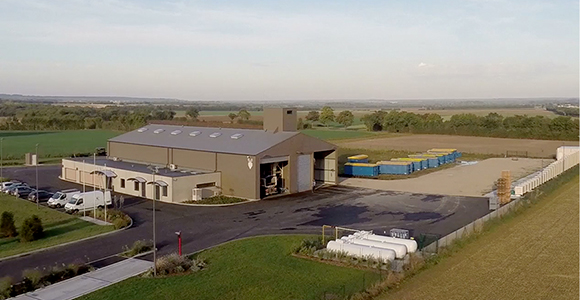Sugar beet
SUGAR BEET SEED PRODUCTION IN A FEW WORDS
Deleplanque produces sugar beetroot seeds in 4 regions and has 2 sugar beet seed stations, Manosque and Villefollet, which is unique in France. The historical partnership between Deleplanque and the German breeder Strube has been ongoing since 1950. They are both in the production and distribution of sugar beet seeds. The Beauce is dedicated to the seed production of multi-germ varieties, and Brittany to the nursery plants, for the production of stecklings which are then transplanted. The Provence and Deux-Sèvres concentrate on growing commercial monogerm seeds and experiments.
All sugar beet seeds produced go through demanding quality control processes, both in the field and in the laboratory. The controls on beetroot seeds have been reinforced for several years by the use of micro-tomography in Strube, which makes it possible to visualise the internal structure of the seeds.
SEVERAL REGIONS OF SUGAR BEET SEED PRODUCTION
To backtrack a little bit, the first productions for Strube began in the early 1950s in Beauce and developed there until 1979, when Deleplanque wanted to create a more southern area for the production of monogerm seeds.
Among all the regions prospected, the Durance valley was chosen as the most interesting. Having never before produced sugar beet as well as spontaneous species of the Beta genus, the region offered a favourable agro-climatic context, excellent phytosanitary conditions, and the possibility of irrigation and drying. In addition, the agricultural structure of the area permitted long rotations.
The region has developed around the Manosque station, in 7 departments, hosting up to 1000 ha of beet seed production.
In 2004, a new region was successfully tested in the Deux-Sèvres department. The objective was to settle in an area with an oceanic climate and a high level of sunshine. The Villefollet station was created in 2014 and about a third of the productions managed by Deleplanque are now produced there.
Today, Beauce is responding to the demand for multigerm seeds. The increase in monogerm commercial seeds and selection work is conducted around the Manosque and Villefollet stations.
3 regions: an indisputable asset !
Management by area is absolutely essential, for both the grower and the seed company. Among the strong points of this framework, we can mention: - The distribution of risks - the different germination times of the sugar beet seeds which makes it possible to spread out the sowing and harvest periods- adaptation between the pedoclimatic conditions of each region and genetic specificities.
THE DIFFERENT TECHNIQUES OF SUGAR BEET SEED PRODUCTION
Direct sowing or transplanting?
Direct sowing
Today, the direct method only concerns multigerm varieties. Sowing of sugar beet is done in late August/early September, usually behind a straw cereal. The harvest takes place 11 to 12 months later. The crop remains in place for a full year. Beetroots that are in the 12-14 leaf stage at the beginning of winter are vernalised by low temperatures and rise to seed in the spring.
Transplanting
Transplanting has completely replaced direct sowing for the production of monogerm sugar beet seeds. Why is this?
Sugar beetroot transplanting takes place in February, i.e. 6 months after direct sowing, when the results of the varietal trials are available. The varietal components can therefore be chosen according to their actual potential for development and the corresponding production area.
- Only the stecklings from selected components are harvested
- The production of sugar beet seeds is adjusted to the foreseeable development of the varieties
- Transplanting provides flexibility that do not exist with direct sowings
The technique of transplanting
The nursery plants are sown in August over 2 regions offering a real pedoclimatic difference: Brittany and the Rhone Valley.
One hectare of nursery plants makes it possible to transplant 10 ha of commercial sugar beet production.
The stecklings are harvested in February, with self-propelled harvesters cutting the root, plucking, digging and calibrating the stecklings. The goal is to harvest when the stecklings reach the size of 30mm diameter at the crown.
The stecklings are shipped as soon as possible to the production site and transplanted manually by multiplying farmers, with the help of transplanters. It takes one day for 6 people to transplant 1 hectare: 4 planters, 1 driver and 1 person to supply stecklings.
The constraints of transplanting
The constraints are numerous and require streamlined organisation.
Weather conditions can have a very heavy impact at this time of the year. They must be favourable for harvesting, but also for transplanting, the coordination between these two operations being essential.
If transplanting is not immediate, it is necessary to be able to keep the stecklings in the cool, away from light and with good hygrometry measurements. Reactivity of the teams and the availability of machines are essential in order to take advantage of weather windows, which are sometimes very tight.
These requirements involve huge amounts of logistics. Finally, ensuring the traceability of millions of stecklings, from sowing nursery plants to transplanting, requires immense rigour at all levels of the organisation.
Specific interventions for the cultivation of seed carriers
- Topping
This operation aims to limit the development of the main stem, to promote the growth of secondary branches. The cutting occurs when the main stem of the beetroot is big enough. A 2nd or even a 3rd pass is made 2 to 3 weeks later to homogenise and reach the plants that could not be truncated during the first intervention.
- Crushing pollinators
The male plants are crushed after flowering, solely for practical reasons: less quantity to harvest, less transport, less drying.
- The harvest, in two stages
The stage of maturity is reached when the almonds have a floury aspect, verified by dissecting the seeds. The plants are first swathed. This operation is carried out using swathing workers equipped with vertical saws. The stems are cut high enough to provide the swath with good ventilation. Natural desiccation occurs within 5 to 8 days. The swaths are then harvested with a conventional grain combine harvester with a pickup truck. The moisture control upon harvesting will determine the need for drying.
The sugar beet seeds are then thoroughly pre-cleaned before being sent to Strube for final preparation.





